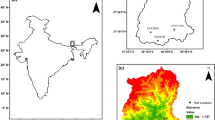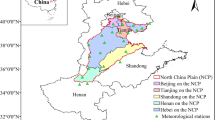Abstract
Land suitability analysis is a necessity to achieve sustainable agricultural productivity with the optimum utilization of the available resources. Lack of proper knowledge on the best combination of factors that suit production of rice and wheat has contributed to low production in the Sone river command, Bihar. The aim of this study is to develop land suitability maps for rice and wheat crop based on physical, chemical and climatic factors of production using a multi-criteria evaluation (MCE) and Geographic Information System (GIS) approach. Biophysical variables of soil, climate and topography have been considered for suitability analysis. This work also evaluates the impact of climate change (CC) on cropland suitability for rice and wheat crops. Climatic variable scenarios of rainfall were obtained from four GCMs (CAN-ESM2, MPI-ESM-MR, CSIRO, CMCC-CMS) for three future time slices (2011–2040, 2041–2070, 2071–2100) of representative concentration pathways (RCP) RCP 2.6, RCP 4.5 and RCP 8.5 scenarios. The observation data (1985–2011) from IMD Pune from 8 meteorological stations were used as the current baseline climatic data of rainfall, which is used to validate the cropland suitability model. The results of CC indicate that there is a significant variability in the distribution of rainfall in the projected period 2011–2100 with respect to the baseline period. The results also show a concomitant increase in the projected crop suitability area of wheat from 17 to 35% and decrease in area for rice from 31 to 21% when compared with baseline for highly suitable area.
















Similar content being viewed by others
References
Ahamed TRN, Rao KG, Murthy JSR (2000) GIS-based fuzzy membership model for crop-land suitability analysis. Agric Syst 63(2):75–95
Ahmad MM, Roy LB, Kumar A (2015) GIS based decision support system for efficient water management in Sone canal command area, IJCSEIERD 5(2): 43–56
Akpoti K, Kabo-bah AT, Zwart SJ (2019) Agricultural land suitability analysis: state-of-the-art and outlooks for integration of climate change analysis. Agric Syst 173(C):172–208
Amanambu AC, Li L, Egbinola CN, Obarein OA, Mupenzi C, Chen D (2019) Spatio-temporal variation in rainfall-runoff erosivity due to climate change in the Lower Niger Basin, West Africa. CATENA 172:324–334. https://doi.org/10.1016/j.catena.2018.09.003
Bandyopadhyay S, Jaiswal RK, Hegde VS, Jayaraman V (2009) Assessment of land suitability potentials for agriculture using a remote sensing and GIS-based approach. Int J Remote Sens 30:879–895
Belka KM (2005) Multicriteria analysis and GIS application in the selection of sustainable motorway corridor. Master’s thesis submitted to linkopingsuniversitetInstitutionen for datavetenskap
Bonfante A, Langella G, Mercogliano P, Bucchignani E, Manna P, Terribile F (2018) Science of the total environment a dynamic viticultural zoning to explore the resilience of terroir concept under climate change. Sci Total Environ 624:294–308. https://doi.org/10.1016/j.scitotenv.2017.12.035
Chen J, Brissette FP, Chaumont D, Braun M (2013) Finding appropriate bias correction methods in downscaling precipitation for hydrologic impact studies over North America. Water Resour Res 49(7):4187–4205
Collins MG, Steiner FR, Rushman MJ (2001) Land-use suitability analysis in the United States: historical development and promising technological achievements. Environ Manag 28:611–621
De la Rosa D, Mayol F, Diaz-Pereira E, Fernandez M, De la Rosa Jr D (2004) A land evaluation decision support system (MicroLEIS DSS) for agricultural soil protection. With special reference to the Mediterranean region. Environ Model Softw 19:929–942
Dell M, Jones BF, Olken BA (2014) What do we learn from the weather? New Clim Econ Lit 52(3):740–798. https://doi.org/10.1257/jel.52.3.740
Duveiller G, Caporaso L, Abad-Viñas R, Perugini L, Grassi G, Arneth A, Cescatti A (2020) Local biophysical effects of land use and land cover change: towards an assessment tool for policy makers. Land Use Policy 91:104382
FAO (1976) A framework for land evaluation, soil bulletin 32, FAO, Rome, 67
FAO (2007) Land evaluation, towards a revised framework. Land and Water Discussion Paper 6. Rome: FAO Electronic publishing division
FAO (2003). State of the World’s Forests. Rome. https://www.fao.org/docrep/fao/005/y7581e/
Feng X, DelSole T, Houser P (2013) Comparison of statistical estimates of potential seasonal predictability. J Geophys Res-Atmos 118:6002–6016. https://doi.org/10.1002/jgrd.50498
Gelybó G, Tóth E, Farkas C, Horel Á, Kása I, Bakacsi Z (2018) Potential impacts of climate change on soil properties. Agrokém Talajt 67(1):121–141
Gong G, Mattevada S, O’Bryant SE (2014) Comparison of the accuracy of kriging and IDW interpolations in estimating groundwater arsenic concentrations in Texas. Environ Res 130:59–69
Gottschalk P, Smith JU, Wattenbach M, Bellarby J, Stehfest E, Arnell N, Osborn TJ, Jones C, Smith P (2012) How will organic carbon stocks in mineral soils evolve under future climate?: global projections using RothC for a range of climate change scenarios. Biogeosciences. 9(8):3151–3171 ISSN 1726-4170
Hopkins LD (1977) Methods for generating land suitability maps: a comparative evaluation. Journal of the American Institute of Planners 43(4):386–400
Jamil M, Sahana M, Sajjad H (2018) Crop suitability analysis in the Bijnor District, UP, using geospatial tools and fuzzy analytical hierarchy process. Agric Res 7(4):506–522. https://doi.org/10.1007/s40003-018-0335-5
Johnson DG (1999) The growth of demand will limit output growth for food over the next quarter century. PNAS 96:5915–5920
Kanlaya T, Songkot D, Chalie N (2009) Integration of land evaluation and the analytical hierarchical process method for energy crops in Kanchanaburi, Thailand. Sci Asia 53:170–177
Kumar S, Roshni T (2019) NDVI-rainfall correlation and irrigation water requirement of different crops in the Sone river-command, Bihar. MAUSAM 70(2):339–346
Kumar S, Roshni T, Pandey NG (2016) Spatial techniques in crop suitability analysis of Mahi sub-basin, proceedings of international conference on hydraulics, water resources and coastal engineering (Hydro2016), CWPRS Pune, India, 157–166
Kumar K, Singh V, Roshni T (2019a) Efficacy of the hybrid neural networks in statistical downscaling of precipitation of the Bagmati River basin. J Water Clim Chang
Kumar S, Roshni T, Himayoun D (2019b) A comparison of emotional neural network (ENN) and artificial neural network (ANN) approach for rainfall-runoff modelling. C E J 5: 2120–2130
Kurtener D, Krueger-Shvetsova E, Dubitskaia I (2004) Quality estimation of data collection. UDMS. UDMS Press, Giorggia-Venice, pp 9101–9109
Lenderink G, Buishand A, Van Deursen W (2007) Estimates of future discharges of the river Rhine using two scenario methodologies: direct versus delta approach. Hydrol Earth Syst Sci 11(3):1145–1159
Malczewski J (2006) GIS-based multi-criteria decision analysis: a survey of the literature. Int J Geogr Inform Sci 20(7):703–726
Manna P, Basile A, Bonfante A, De MR, Terribile F (2009) Comparative land evaluation approaches: an itinerary from FAO framework to simulation modelling. Geoderma 150(3):367–378. https://doi.org/10.1016/j.geoderma.2009.02.020
Mehr AD, Kahya E (2017) Grid-based performance evaluation of GCM-RCM combinations for rainfall reproduction. Theor Appl Climatol 129(1–2):47–57
Mustafa AA, Man S, Sahoo RN, Nayan A, Manoj K, Sarangi A, Mishra AK (2011) Land suitability analysis for different crops. A multi criteria decision making approach using remote sensing and GIS. Indian Agricultural Research Institute, New Delhi-110 012
Patel JH, Markand PO (2014) Deriving crop calendar using NDVI time-series. Int Arch Photogramm Remote Sens Spat Inf Sci 40:869
Perveen F, Ryota N, Imtiaz U, Hossain KMD (2007) Crop land suitability analysis using a multicriteria evaluation and GIS approach, 5th international symposium on digital earth. The University of California, Berkeley, 1–8
Plouffe CC, Robertson C, Chandrapala L (2015) Comparing interpolation techniques for monthly rainfall mapping using multiple evaluation criteria and auxiliary data sources: a case study of Sri Lanka. Environ Model Softw 67:57–71
Rosegrant MW, Paisner MS, Meijer S, Witcover J (2001) Global food projections to 2020. Emerging trends and alternative future. International Food Policy Research Institute, Washington, DC
Saaty TL (1980) The analytic hierarchy process. Planning, priority setting, resource allocation. McGraw Hill, New York, USA
Saaty TL (2004) Decision making the analytic hierarchy and network processes (AHP/ANP). J Syst Sci Syst Eng 13:1, 35
Salas JD (1993) Analysis and modeling of hydrologic time series. Handbook of hydrology 19:1–72
Samanta S, Pal B, Pal DK (2011) Land suitability analysis for rice cultivation based on multi-criteria decision approach through GIS. IJSET 2 (1): 12–20
Sarkar A, Ghosh A , Banik P (2014) Multi-criteria land evaluation for suitability analysis of wheat: a case study of a watershed in eastern plateau region, India, Geo-Spat Inf Sci, 17(2): 119–128. DOI: https://doi.org/10.1080/10095020.2013.774106
Shashikanth K, Sukumar P (2017) Indian monsoon rainfall projections for future using GCM model outputs under climate change. Adv Comput Sci Technol 10(5):1501–1516
Tesfaye K, Aggarwal PK, Mequanint F, Shirsath PB, Stirling CM, Khatri-Chhetri A, Rahut DB (2017) Climate variability and change in Bihar, India: challenges and opportunities for sustainable crop production. Sustainability 9:1998
Tubiello FN, Ewert F (2002) Simulating the effects of elevated CO2 on crops: approaches and applications for climate change. Eur J Agron 18:57–74
U.S. Climate Change Science Program (USCCSP) (2008) Weather and climate ex-tremes in a changing climate, U.S. Climate Change Science, Program Synthesis Analysis Production 3.3〈http://www.climatescience.gov/Library/sap/sap3-3/final-report/sap3-3-final-allpdf〉
USDA (United States Department of Agriculture)-NRCS (National Resources Conservation Service) (1998) Soil quality information sheet. Soil Quality Institute, NRCS, USDA, and the National Soil Tilth Laboratory, GEO-SPATIAL INFORMATION SCIENCE 343 Agricultural Research Service, USDA. https://www.nrcs. usda.gov/Internet/FSE_DOCUMENTS/nrcs142p2_052208.pdf
Voodg H (1983) Multicriteria evaluation for urban and regional planning. Pion, London
Wójcik R (2015) Reliability of CMIP5 GCM simulations in reproducing atmospheric circulation over Europe and the North Atlantic: a statistical downscaling perspective. Int J Climatol, 35: 714–732. https://doi.org/10.1002/joc.4015
Worqlul AW, Jaehak A, Dile YT, Osorio J, Schmitter P, Gerik T, Clark N (2017) Assessing potential land suitable for surface irrigation using groundwater in Ethiopia. Appl Geogr 85(1):1–13. https://doi.org/10.1016/j.apgeog.2017.05.010
Yan D, Werners SE, Ludwig F, Huang HQ (2015) Hydrological response to climate change: the Pearl River, China under different RCP scenarios. J Hydrol Reg Stud, 4:228–245
Yang X, Xie X, Liu DL, Ji F, Wang L (2015). Spatial interpolation of daily rainfall data for local climate impact assessment over greater Sydney region. Adv Meteorol 2015, 1, 12
Acknowledgements
The authors are grateful to Indian Meteorological Department (IMD), Pune, for the supply of climatic data used for carrying out this research work.
Author information
Authors and Affiliations
Corresponding author
Ethics declarations
Conflict of interest
The authors declare that they have no known competing financial interests or personal relationships that could haveappeared to influence the work reported in this paper.
Additional information
Publisher’s note
Springer Nature remains neutral with regard to jurisdictional claims in published maps and institutional affiliations.
Rights and permissions
About this article
Cite this article
Kumar, S., Roshni, T., Kahya, E. et al. Climate change projections of rainfall and its impact on the cropland suitability for rice and wheat crops in the Sone river command, Bihar. Theor Appl Climatol 142, 433–451 (2020). https://doi.org/10.1007/s00704-020-03319-9
Received:
Accepted:
Published:
Issue Date:
DOI: https://doi.org/10.1007/s00704-020-03319-9




